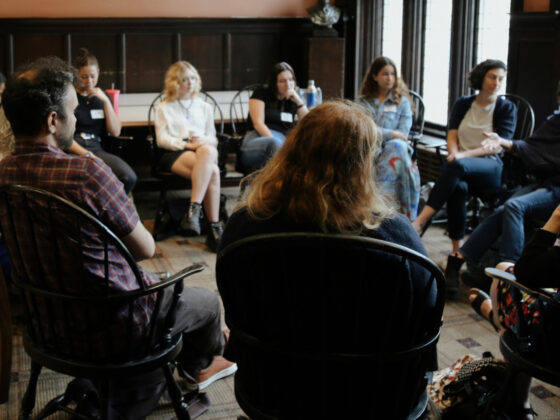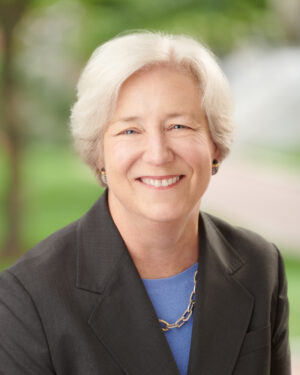News Details
SP2 highlights Disability Visibility book and Penn & Slavery tour as 2023-2024 begins

Authored by: Carson Easterly
Photography by: Carson Easterly
Student Life
09/08/23
Among a variety of events commemorating the beginning of the fall semester, Penn’s School of Social Policy & Practice (SP2) offered opportunities for conversation, reflection, and learning driven by the School’s social justice mission. These included small-group discussions of the 2023-2024 One Book, One SP2 book choice and augmented reality campus tours with the Penn & Slavery Project.
One Book, One SP2 discussions emphasize community, intersectionality, & disability justice
On August 22 and 28, SP2 students, faculty, alumni, and staff convened for small-group discussions of the 2023-2024 selection for the One Book, One SP2 project – a school-wide collective reading initiative now in its fifth year. The One Book is selected by SP2’s Committee on Race and Social Justice following a survey of alumni, students, faculty, and staff at the School.
This year’s choice is Disability Visibility: First-Person Stories from the Twenty-First Century edited by disability rights activist Alice Wong. An anthology of essays by 35 individuals with disabilities, the book describes the complexities of their everyday life experiences, presenting a diverse perspective often missing in conversations in and out of the classroom.
At SP2’s 2023 Convocation, Dean Sara S. Bachman highlighted the book’s lessons for the year ahead, including the power of community to transform the status quo. “This is exactly what we will do this year – transform the status quo,” said Dr. Bachman. “I know that you will engage in our community while you are here at SP2, and then you will carry our conversations about all that you have learned and about disability and oppression long after you leave us.”
In her Convocation remarks, Associate Dean for Inclusion Dr. Jerri Bourjolly, who leads the Committee on Race and Social Justice, said Disability Visibility’s themes of “interdependence, inclusion, and belonging are not only valued here at SP2, but they are essential to our well-being.”
A main objective of the One Book initiative is to build and strengthen connections within the SP2 community through opportunities for dialogue. As part of this aim, SP2 alumni, staff, and students have the opportunity to serve as facilitators for the small-group discussions and engage with individuals across the School. The book and ensuing discussions brought visibility to the community, culture, and daily life of the disability community.
“Being a One Book discussion facilitator is a great way to connect with the larger SP2 community in a special way,” says Mary Archer, MSW ’17, program director of SP2’s Goldring Reentry Initiative, who served as a facilitator for virtual discussions on August 22. “I really appreciate that SP2 creates the space for these connections through the shared experience of reading a book and engaging in meaningful discussion.”
Dr. Mary Mazzola, SP2’s associate dean of enrollment management and global outreach, has served as a facilitator each year since the inception of the One Book initiative. An alumna of SP2’s Master of Social Work (MSW) program, Dr. Mazzola earned her EdD in Higher Education Management at Penn’s Graduate School of Education. Mazzola shares that this year’s selection was particularly meaningful to her as she has a family member who became disabled in recent years.
“What stands out for me is the complexity of experiences for individuals with both visible and invisible disabilities,” says Mazzola. “Also, how difficult it is to navigate various ‘systems’ to access services that are far from plentiful. Advocacy is essential but often frustrating.”
Facilitator Daniel Price, NPL’23, echoes Mazzola’s conclusions from the experience, “My biggest takeaway was the detail and nuance the authors went [in] to explain how disability has a profound impact on their lives and how they handle and process those moments.”
Serving as a facilitator also provides alumni with a unique opportunity to engage with the community. As a retired educator, facilitator Sue Bowden, MSW ’75, says she enjoyed leading a conversation and connecting with current MSW students.
In addition to propelling discussions during New Student Orientation, the One Book initiative will continue to facilitate dialogue and community connections throughout the year.
Penn & Slavery tours shed light on hidden history & showcase student research
On Thursday, August 24, SP2 students were invited to participate in guided augmented reality (AR) tours of Penn’s campus offered through the Penn & Slavery Project (P&SP), a student-led research initiative exploring the connections between the University of Pennsylvania and the institution of slavery. Associate Professor Amy Hillier, MSW, PhD, organized the tours for the SP2 community.
The first-of-its-kind tour includes six stops on campus where the Penn & Slavery AR mobile app can be accessed to learn about different components of the University’s historical relationship with slavery. At each location, participants open the app to activate AR exhibits that dive into student research. Exhibits include audio narration and interactive images integrated into the real world through the phone’s camera.
Stop number one — the Benjamin Franklin statue in front of College Hall — focuses on “Caesar’s Story.” Enslaved by Penn’s first English professor Ebenezer Kinnersley, Caesar worked on Penn’s early campus from around 1757 to 1770. His labor included building fires and ringing the school bell that alerted students it was time for class. By using the app to scan the back panel of the statue, users can view a painting featuring Caesar standing alongside Kinnersley and his wife. Caesar comes to life in the painting to tell his story and give an introduction to the Penn & Slavery tour.
Other topics highlighted on the tour include the role of Penn and its alumni in the production of scientific racism, the erasure of African American medical professionals on campus, the founders’ financial connections to wealthy enslavers, and monuments to enslavers on campus.
For SP2 student Jalen Belgrave, MSSP ’24, the tour was essential “to understanding the impact of white supremacy within the community and campus of Penn.” Following the tour, Belgrave concluded that acknowledging and owning this history is an important and long journey for the University.
VanJessica Gladney, a graduate student pursuing her PhD in History, served as a tour guide for SP2 students. Gladney, who graduated from Penn with a bachelor’s in English in 2018 and a master’s in history in 2021, was one of the original undergraduate researchers for the project and currently serves as P&SP’s digital historian. In this role, she helped develop the AR mobile app and continues to manage the project’s website.
“I think it’s crucial for the people who committed to learning at and from Penn [to] learn about Penn as well. And there’s something uniquely revelatory about the experience of standing in a space while learning its history,” says Gladney, who appreciated that P&SP was part of new SP2 students’ introduction to campus. “One thing I kept hearing the students say was, ‘Everyone on campus should take this tour!’”
The project’s mobile app launched in 2021, and P&SP began offering guided, in-person campus tours this year. Since beginning tours, the P&SP team has had the opportunity to engage a number of Penn students and plans to continue expanding their reach.
SP2’s One Book program and participation in the Penn & Slavery tour underscore the School’s commitment to producing social service providers, policymakers, and nonprofit leaders with an intrinsic dedication to diversity, equity, and inclusion. For updates on social justice and inclusion programming during the year ahead, visit the SP2 events calendar.
People
-

Sara S. Bachman, PhD
Dean
Contact
office: 215.898.5512
fax: 215.573.2099
Email
-

Joretha N. Bourjolly, MSW, PhD
Associate Professor/Clinician Educator
Contact
office: 215.898.5524
fax: 215.573.2099
Email
-

Mary Mazzola, MSW, EdD
Associate Dean, Enrollment Management and Global Outreach
Contact
office: 215.898.5550
fax: 215.746.1300
Email
-

Amy Hillier, MSW, PhD
Associate Professor, School of Social Policy & Practice
Contact
office: 215.746.5486
fax: 215.573.2099
Email